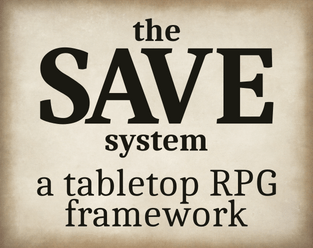SAVE System Reference Document
These rules are available for use under the Creative Commons Attribution 4.0 International License. To view a copy of this license, visit http://creativecommons.org/licenses/by/4.0/ or send a letter to Creative Commons, PO Box 1866, Mountain View, CA 94042, USA.
This is a framework for creating a roleplaying game, not a complete game. For an example of a complete game based on SAVE, check out Save the Universe at https://dbisdorf.itch.io/save-the-universe.
SAVE is a core set of rules and principles for a tabletop roleplaying game. The rules of SAVE are simple and quickly taught. They promote improvisation and collaborative storytelling, reducing the work necessary to prepare and facilitate the game. Players build their characters from roles that illustrate genre archetypes, and from descriptions of talents and past events rather than mathematical statistics.
A SAVE game helps a group of players tell stories in a certain genre or in a certain style of imaginary world. It might be a game of cinematic sci-fi adventure, or contemporary urban fantasy, or bloody swords and sorcery.
When you’re designing a SAVE game, you provide:
- A list of the actions that commonly produce risk and drama in the game’s genre.
- A selection of roles that heroes in this genre will tend to embody.
- A list of world-building questions that will help a group of players design their own game world in swift, broad strokes.
Anyone playing a SAVE game must provide:
- At least two players. One player will become the guide and facilitate the game; the remaining players will portray heroes.
- A means for keeping track of character details, such as paper and pencils or electronic documents.
- At least two six-sided dice, or a means of simulating dice rolls. It will be more convenient if every player portraying a hero has their own two dice.


